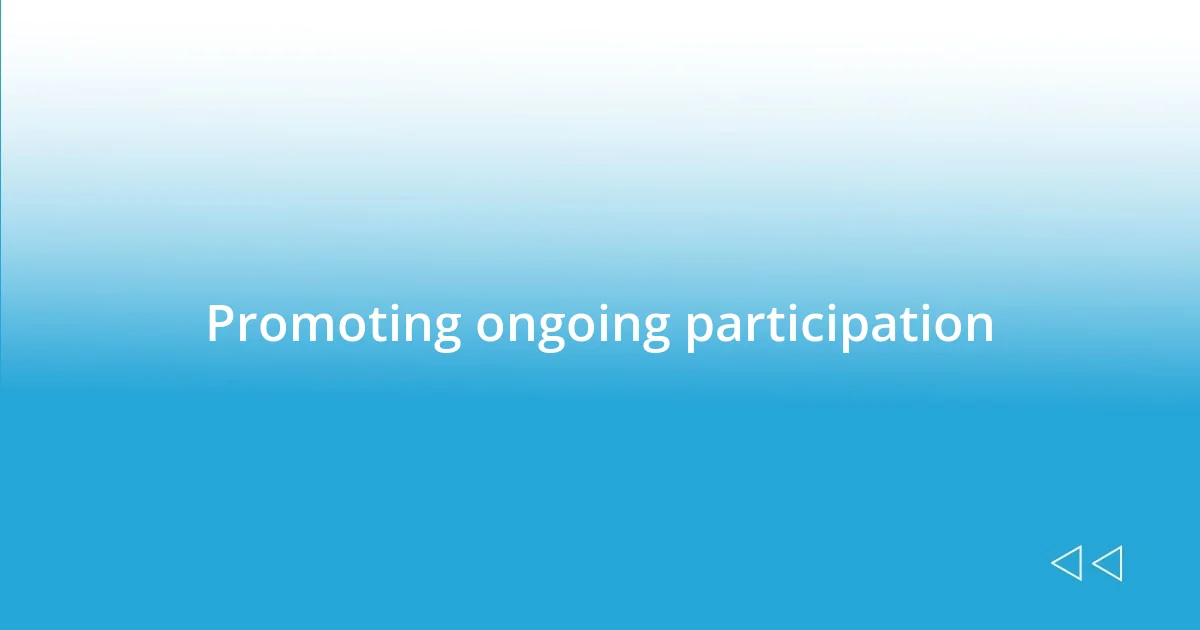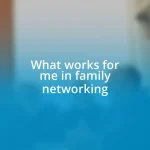Key takeaways:
- Identifying community needs through active listening and ongoing engagement is essential for understanding shifting challenges, particularly during crises like the pandemic.
- Establishing a clear, inclusive mission statement fosters accountability, focus, and a shared sense of purpose within the group.
- Creating a supportive environment that encourages vulnerability, celebrates achievements, and provides consistent opportunities for participation strengthens community bonds.

Identifying community needs
Identifying community needs starts with listening. I remember sitting in a small café, chatting with neighbors, when their concerns spilled out: a lack of mental health resources, support for new parents, and even safe spaces for teenagers. It struck me how often we overlook these voices while assuming we know what our community truly needs.
When I later conducted a survey, I was surprised by the results. The numbers revealed a strong desire for connection and support that wasn’t being met. It made me wonder, how often do we take the time to hear these unspoken needs? Real engagement means digging deeper, beyond surface-level assumptions, to uncover the heart of what people genuinely desire.
I often reflect on how community needs can shift over time. For instance, during the pandemic, discussions shifted dramatically as isolation became a major focus. I found myself asking, what are the new challenges people are facing now? The answers, often filled with emotion, highlighted an urgent need for help that I hadn’t anticipated, showcasing the importance of regularly reevaluating our community’s landscape.

Recruiting group members
Recruiting group members can feel daunting, but I found that making genuine connections is essential. I started by tapping into my existing network, reaching out to friends, family, and acquaintances who might resonate with the vision I had for the group. Their enthusiasm turned out to be contagious—soon, I was not just recruiting, but igniting interest in the cause.
Here are some practical strategies I used to recruit members:
- Social Media Outreach: I crafted engaging posts that shared not just the purpose but also the heartfelt stories behind the group. Visuals and personal experiences drew people in.
- Community Events: By attending local gatherings, I fostered conversations about the group’s mission, which helped me identify potential members who shared similar passions.
- Flyers and Local Resources: I created simple, eye-catching flyers with clear, inviting messages. Placing them in community centers and local businesses spread awareness and interest.
- Word of Mouth: Encouraging early members to share their excitement with others led to organic growth, where personal recommendations became powerful recruitment tools.
Through each effort, I realized that my personal touch—sharing my own journey and vulnerabilities—made a significant difference. It was about building a community, not just a group, and the emotional connections we formed while recruiting laid the foundation for trust and unity in our support network.

Establishing a group mission
Establishing a clear mission for our support group was a pivotal moment. As I sat with a few founding members, we brainstormed the core values we wanted to promote. I vividly recall someone saying, “Let’s not just support; let’s empower.” That statement resonated deeply with me and set the direction. It’s like putting a flag at the top of a mountain; it gives everyone something to rally around.
I remember feeling a sense of accountability as we crafted our mission statement. We knew that without clarity, the group could easily lose focus. We decided on a mission that not only addressed specific needs but also encouraged personal growth. Reflecting on my own struggles with self-doubt, I wanted others to feel that support could be a stepping stone to discovering their own strength. It was about more than helping; it was about lifting each other up collectively.
To keep our mission alive, we regularly revisited it during meetings. We’d discuss how our activities aligned with our purpose, and I found that celebrating small victories in our journey reinforced our commitment. Each success story shared reminded us why we started. I often think about how important it is to stay true to your mission in the face of challenges. It’s a compass guiding us through uncertainty and reinforcing the bond within our community.
| Elements of a Strong Mission Statement | Insights from My Experience |
|---|---|
| Clarity | Unequivocal clarity helps everyone understand the group’s purpose. I remember the sigh of relief when our members articulated what we stood for. |
| Inclusivity | We made it a point to ensure that our mission language was open and welcoming. Every voice mattered, and I often reminded myself that diversity strengthens our community. |
| Measurable Impact | We set goals we could track—whether through feedback or participation. Achieving these goals made me feel proud and solidified our mission’s relevance. |

Creating a supportive environment
Fostering a warm and inviting atmosphere was crucial in my journey of creating a support group. I remember the first meeting vividly; I made sure the seating arrangement was welcoming, with chairs in a circle to encourage open dialogue. The moment everyone shared their stories, I felt the room shift. It became clear that emotional safety is paramount. Have you ever felt hesitant to share in a group? I certainly have, and I wanted to avoid that discomfort for others.
Inclusion also played a huge role in crafting our supportive environment. I actively sought feedback from members on how they felt about our activities and discussions. One member’s suggestion to incorporate “check-in” moments at the start of each meeting transformed the experience. It not only allowed everyone to express what they were bringing to the table emotionally but also helped to forge connections based on shared experiences. Have you noticed how simply checking in can build bridges between people? It was powerful to watch these small moments of vulnerability evolve into deep bonds over time.
Celebrating achievements, no matter how small, became a cornerstone of our community. I initiated a “win of the week” segment, where members could highlight personal successes or breakthroughs. I distinctly recall the joy on a newcomer’s face when they shared that they had taken a long walk after weeks of feeling isolated. It was exhilarating to witness individual growth reflected back at us as a group. These celebrations underscored the idea that every step forward, no matter how tiny, was worth acknowledging. How uplifting is it to know we’re cheering each other on? That sense of solidarity has enriched our journey significantly.

Organizing initial meetings
Organizing the initial meetings was an adventure filled with excitement and nerves. I remember sitting at my kitchen table, jotting down possible dates, and feeling that familiar flutter of anticipation. I had learned from past experiences that setting a consistent schedule helps build momentum. So, I settled on a bi-weekly meeting, thinking, “Let’s keep the door wide open for everyone.”
Selecting a location was also a critical step. I chose a local community center because it was accessible and familiar to many in our area. Have you ever walked into a place that instantly felt welcoming? That was my goal—creating a space where everyone felt they belonged. The first time I walked into the center, imagining the conversations that would unfold, I felt a rush of hope. It was about more than just a room; it was about creating a sanctuary for vulnerable sharing.
As we prepared for our first meeting, I intentionally crafted an agenda that included introductions and icebreakers. I believed in the power of storytelling and how personal experiences can forge connections. During that initial gathering, I shared a bit about my own journey, hoping to inspire others to open up. I distinctly recall the moment someone nervously shared their story, their voice trembling with authenticity. It hit me—every shared narrative stitched us closer together, and it was this exchange of vulnerability that truly formed the foundation of our group. Isn’t it wonderful how sharing our stories can lighten our burdens?

Promoting ongoing participation
To promote ongoing participation, I found it essential to create a sense of ownership among group members. I often encouraged individuals to lead discussions or share their expertise, giving them a platform to shine. The first time a member volunteered to host a session, I could see their eyes light up with excitement. Have you ever noticed how empowerment can transform a person? It’s remarkable how taking charge can deepen one’s commitment to the group.
Engaging members beyond meetings also proved vital. I initiated a private online group where we could share resources, experiences, and support in between our gatherings. I vividly recall a particularly poignant moment when a member shared a tough day, and immediately, others chimed in with uplifting messages. It highlighted the genuine connections we were forming. Isn’t it heartwarming to know someone is always just a message away?
Feedback became my best friend in sustaining participation. After each meeting, I would ask members for their thoughts. One time, a member suggested we try themed sessions—what a game-changer that was! We suddenly had night dedicated to coping strategies, and the energy was palpable. I felt honored that they were willing to share their ideas, proving that everyone’s voice matters. How do you think inclusivity can shape a community’s growth? For us, it led to richer discussions and a deeper commitment to being present.

Evaluating group effectiveness
Evaluating group effectiveness requires a keen eye for both quantitative and qualitative indicators. I always kept a journal to track attendance patterns and member engagement over time, which offered clear insights into our growth. Have you ever looked back at something over time and realized how far you’ve come? It’s such a powerful moment to reflect on.
An essential part of my evaluation process included informal check-ins with members. I’d often grab coffee with someone after a meeting, just to hear their thoughts. One particularly enlightening conversation revealed that while members loved the group, they desired more structured activities. Listening to this feedback was a pivotal moment for me; it reminded me that the group thrives on the comfort and needs of its community.
Finally, recognizing the emotional climate of the group played a crucial role in assessing our effectiveness. I learned to gauge the overall mood through non-verbal cues during our gatherings. Sometimes a simple question like, “How is everyone feeling today?” would spark a deeper conversation. I distinctly remember a meeting where silence hung in the air, and those moments of reflection brought an unexpected wave of camaraderie. Isn’t it profound how shared emotions can bind us together?
















